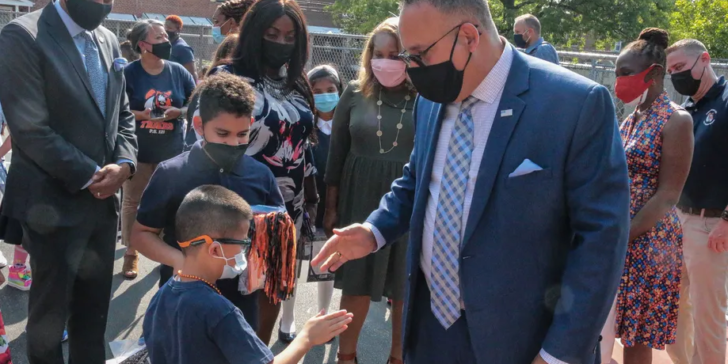
Some Michigan school districts face the prospect of returning millions of federal COVID relief dollars after federal officials warned that Michigan’s plan to distribute the money may be illegal.
When Michigan lawmakers distributed the latest round of federal aid to schools, they set aside $362 million for districts with the lowest poverty rates. But before the money went out, the U.S. Education Department informed state leaders that the plan didn’t appear to meet a legal requirement to “take into account the ‘disproportionate impact’ of the pandemic on underserved populations,” according to the Michigan Association of Superintendents and Administrators.
When U.S. Education Secretary Miguel Cardona visits Michigan this week, advocates say they plan to press him to change the department’s stance. A spokesperson for the federal education department confirmed that Michigan’s plan is under review but declined further comment.
Budgets for nearly 250 Michigan school districts would be thrown into chaos if federal officials reject Michigan’s plan. Once education funds have been allocated to schools, clawbacks are highly unusual.
Michigan will receive more than $6 billion in COVID relief funds, almost all of which is being distributed directly to districts using a formula Congress designed to favor communities with more low-income families. Proponents of the plan argued that students in those communities were hardest hit by the pandemic and will need more help recovering from its negative academic and emotional effects.
When state lawmakers distributed the latest round of funding in July, they set aside a small part of the money to ensure that no district received less than $1,093 per pupil, arguing that COVID would impose higher costs on all districts, even those in the most affluent parts of the state.
The funds in question make up a sliver of the federal COVID aid going to Michigan schools, but the money is highly significant to the districts slated to receive it.
“The whole purpose … is to ensure that every student is getting the support they need in terms of recovery this year,” said Bob McCann, executive director of the K-12 Alliance, an advocacy group representing schools in southeast Michigan that supported the equalization payments.
The payments, which are planned for release when the school fiscal year begins Oct. 1, are “about raising the floor up and saying there’s a minimum amount that every student needs this year,” he said.
More than a dozen states, including Michigan, previously provided extra federal funds to districts that received the least through the formula, according to an analysis by the Education Commission to the States, a nonpartisan research group, that was provided to Chalkbeat.
Michigan followed the same plan with money from the third round of the program, which specified that spending needed to recognize the disproportionate impact of the pandemic on disadvantaged kids.
Federal officials declined to say if other states have tried to use third-round funds to support districts in higher income areas, or if other states’ plans have attracted similar federal scrutiny.
Under Michigan’s plan, districts with fewer students from low-income families receive a larger share of the $356 million “equalization payments.”
L’anse Creuse Public Schools, in the northeastern suburbs of Detroit, is in line to receive $1.6 million in so-called “equalization” payments, or $165 per pupil. Roughly 44% of the students in the district are considered economically disadvantaged by the state.
Rochester Community Schools, a large district in an affluent suburb north of Detroit, is supposed to receive an estimated $14 million in equalization payments, or $943 per pupil. That’s more than half of the district’s total federal aid, according to spokesperson Lori Grein. About 14% of the district’s 15,100 students are classified as economically disadvantaged.
The funds have already been budgeted to help students recover academically and emotionally from the pandemic year, said Grein and L’anse Creuse Superintendent Erik Edoff.
“We’re using it for literacy support, we’re using it for counseling support, social work support,” Edoff said. “We wouldn’t have done those things if it weren’t for that money.”
He said the district began to build a budget around those funds when they were approved in July. He said he’s optimistic that a resolution will be found, in part because it would be very difficult for the roughly 250 districts that are counting on the money to change course.
Craig Thiel, research director at the nonpartisan Citizens Research Council of Michigan, said state lawmakers who designed the equalization payments were taking an approach to state funding that is the norm in Michigan: First provide equal payments to school districts, then provide additional equity funding to districts with greater needs.
That approach, he said, has come into conflict with a federal law that “put a premium on equity funding, but ignored the first step of equalizing funding.”
This article was originally posted on U.S. questions Michigan plan to send COVID aid to affluent districts